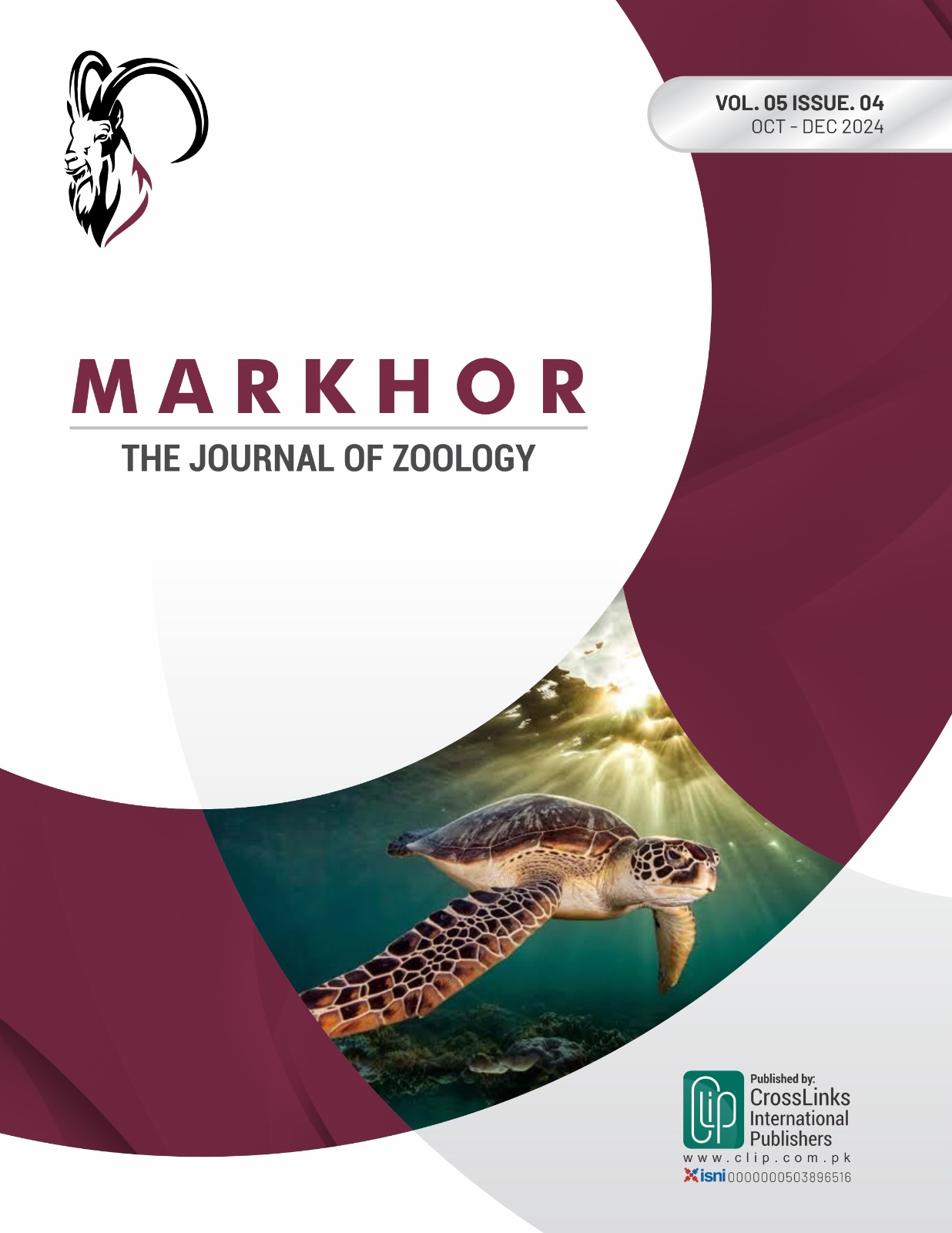Impact of Land Use Gradient on Bird Community Structure and Diversity at University of the Punjab, Quaid-e-Azam Campus, Lahore
Impact of Land Use Gradient on Bird Community Structure and Diversity
DOI:
https://doi.org/10.54393/mjz.v5i04.190Keywords:
Birds Diversity, Scavengers, Solid Wastes, Urbanization, Punjab University, 10-Minute Point Counts PointAbstract
Growth and development in cities and alterations in land use have a considerable impact on the avian diversity in urbanized landscapes. Objectives: To assess current avian diversity, seasonal variation, and long-term changes (1997–2023) in relation to land-use modification within the campus. Methods: Fortnightly bird surveys were conducted from May 2022 to April 2023 using the 10-minute point count method at 40 fixed stations representing urban, agricultural, botanical, and wetland habitats. Diversity indices, including the Shannon–Wiener index, species richness, and evenness, were calculated. The methodologies and spatial coverage of these historical studies were not identical to the current survey, and some historical records lacked fine-scale spatial or seasonal data, which is a recognized limitation for direct comparison. Results: There were 64 species of birds of 16 orders and 34 families, 40 resident, 10 summer breeding, 8 winter visitor, 5 passage migrant, and 1 vagrant species. The dominance was Passeriformes (63%), non-passerines (37%). The scavenger and generalist birds Corvus splendens, Milvus migrans, and Acridotheres tristis formed more than half the total population. Comparison of trends over a long period revealed a decreasing common myna population and a house crow population, no changes in black kite population, and an increasing prevalence of plain-leaf warbler, yellow-footed green pigeon and cattle egret. Since 2012, urbanization has decreased agricultural habitats and homogenized bird communities. Conclusions: Urbanization and the environment of littering have altered the avian diversity, thus the necessity to incorporate biodiversity preservation into urban and campus landscape designs.
References
Ahmad R, Ali Z, Manzoor F, Ahmad U, Sidra S, Zainab I et al. Avian Diversity, Abundance and Habitat Suitability Index for Threatened Species in Selected Areas of Northern Pakistan. Pakistan Journal of Zoology. 2022; 55: 1-9. doi: 10.17582/journal.pjz/20220224070218.
Khan RU, Gabol K, Khan A, Sadam A, Panhwar WA, Ullah H et al. Avian Diversity and its Associated Threats in Gharo Creek, District Thatta, Sindh, Pakistan. Pakistan Journal of Zoology. 2024 Apr; 56(2): 725. doi: 10.17582/journal.pjz/20210913070932.
Mariyappan M, Rajendran M, Velu S, Johnson AD, Dinesh GK, Solaimuthu K, Kaliyappan M, Sankar M. Ecological role and ecosystem services of birds: A review. International Journal of Environment and Climate Change. 2023; 13(6): 76-87. doi: 10.9734/ijecc/2023/v13i61800.
Deng GT and Yimam IA. Ecosystem Roles of Birds: A Review of Birds’ Conservation Insight. International Journal of Zoology and Animal Biology. 2020; 3(4): 1-7. doi: 10.23880/IZAB-16000236.
Andersen AH, Clausen KK, Normand S, Vikstrøm T, Moeslund JE. The Influence of Landscape Characteristics on Breeding Bird Dark Diversity. Oecologia. 2023 Apr; 201(4): 1039-52. doi: 10.1007/s00442-023-05351-8.
Anderle M, Paniccia C, Brambilla M, Hilpold A, Volani S, Tasser et al. The contribution of landscape features, climate and topography in shaping taxonomical and functional diversity of avian communities in a heterogeneous Alpine region. Oecologia. 2022 Jul; 199(3): 499-512. doi: 10.1007/s00442-022-05134-7.
Umar M, Hussain M, Lee DC. Seasonal Diversity and Distribution Patterns of Birds in Agricultural Landscapes of Gujrat, Pakistan. Pakistan Journal of Zoology. 2022: 1-2. doi: 10.17582/journal.pjz/20200207190214.
McWhorter TJ, Rader JA, Schondube JE, Nicolson SW, Pinshow B, Fleming PA et al. Sucrose Digestion Capacity in Birds Shows Convergent Coevolution with Nectar Composition Across Continents. IScience. 2021 Jul; 24(7). doi: 10.1016/j.isci.2021.102717.
Haider MZ, Ahmed S, Sial N, Afzal G, Riaz A, Asif AR et al. Avian Diversity and Abundance of Taunsa Barrage Ramsar site in Punjab, Pakistan. Journal of Zoological Systematics and Evolutionary Research. 2022; 2022(1): 4736195. doi: 10.1155/2022/4736195.
Rasool G, Aihetasham A, Ali Z, Ahmad R. Avian Richness, Assemblages and Migration Connectivity of Geese Species with Habitat Suitability in Wetlands of the Punjab, Pakistan. Pakistan Journal of Zoology. 2024 Oct; 56(5): 2401. doi: 10.17582/journal.pjz/20230724085011.
Khan MS, Javeed F, Anbrine S. The Impacts of Urbanization on Avian Communities of Lahore. Department of Architecture and Planning, NED University of Engineering and Technology, City Campus, Maulana Din Muhammad Wafai Road, Karachi. 2015 Jun: 23. doi: 10.53700/jrap1812015_3.
Khan AA, Aqsa T, Shahid MA. Urban Vegetation and Population Variability in Pakistan. A GIS and Remote Sensing Analysis of Peshawar, Karachi, and Lahore (1990-2020). Pakistan Research Journal of Social Sciences. 2023 Dec; 2(4).
Tanveer A, Shahzad M, Chaudhry AA. Avian fauna of Punjab University, Lahore [Pakistan]. Punjab University Journal of Zoology (Pakistan). 2002; 17.
Saleem M, Javid A, Hussain A, Mehmood S. Diversity and Molecular Identification of Bird Species from South Punjab, Pakistan. Journal of Wildlife and Biodiversity. 2025 Jan; 9(1): 280-99.
Díaz M, Ramos A, Concepción ED. Changing Urban Bird Diversity: How to Manage Adaptively Our Closest Relation with wildlife. Ecosistemas. 2022 Apr; 31(1): 2354-. doi: 10.7818/ECOS.2354.
Sidra S, Ali Z, Chaudhry MN. Avian Diversity at New Campus of Punjab University in Relation to Land Use Change. Pakistan Journal of Zoology. 2013 Aug; 45(4).
Patankar S, Jambhekar R, Suryawanshi KR, Nagendra H. Which Traits Influence Bird Survival in the City? A Review. Land. 2021 Jan; 10(2): 92. doi: 10.3390/land10020092.
Bonnet-Lebrun AS, Manica A, Rodrigues AS. Effects of Urbanization on Bird Migration. Biological Conservation. 2020 Apr; 244: 108423. doi: 10.1016/j.biocon.2020.108423.
McKinney ML. Urbanization as a Major Cause of Biotic Homogenization. Biological Conservation. 2006 Jan; 127(3): 247-60. doi: 10.1016/j.biocon.2005.09.005.
Grünwald J and Reif J. Urban Bird Assemblages in India: The Role of Traffic, Greenspaces, and Dietary Traits in Shaping Community Composition. Urban Ecosystems. 2025 Jun; 28(3):1 18. doi: 10.1007/s11252-025-01732-4.
Downloads
Published
How to Cite
Issue
Section
License
Copyright (c) 2024 MARKHOR (The Journal of Zoology)

This work is licensed under a Creative Commons Attribution 4.0 International License.
This is an open-access journal and all the published articles / items are distributed under the terms of the Creative Commons Attribution License, which permits unrestricted use, distribution, and reproduction in any medium, provided the original author and source are credited. For comments editor@markhorjournal.com











